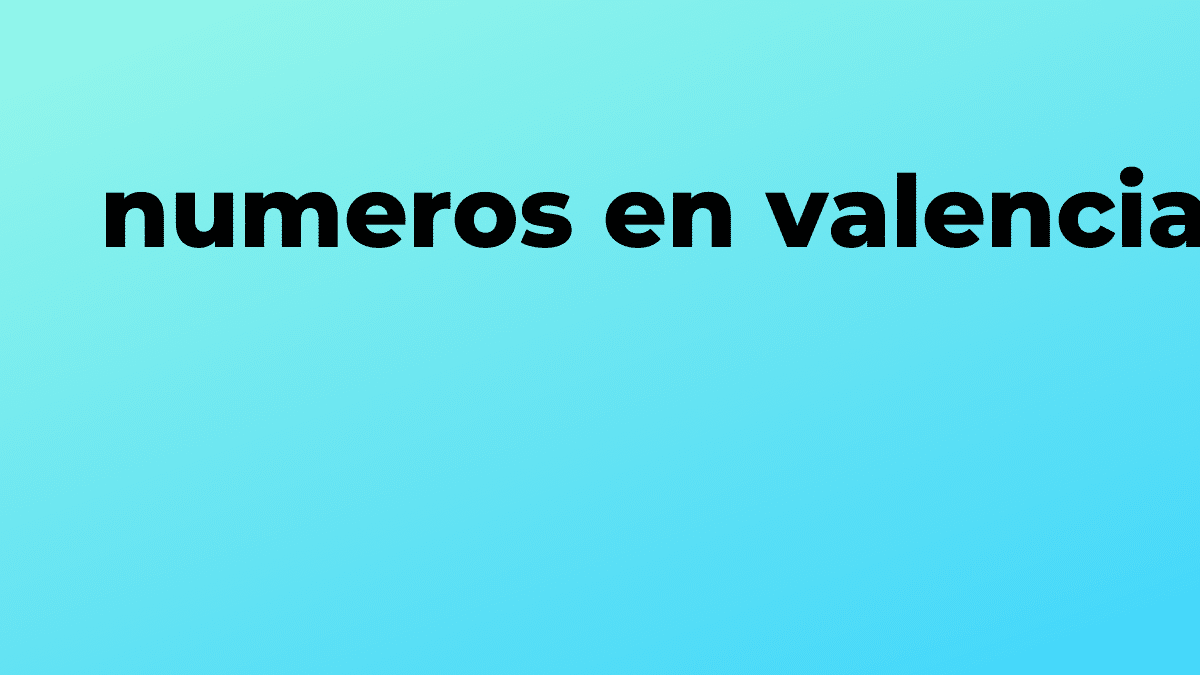
Valencian is a Romance language that is part of the Catalan language family. It is spoken mainly in the Valencian Community, in Spain, and is co-official along with Spanish. Although Valencian and Catalan share many similarities, there are differences in vocabulary, pronunciation, and grammar. In this article, we will focus on the numbers in Valencian and its pronunciation. Numbers in Valencian, as in other languages, are essential to communicate in everyday situations, such as counting, performing mathematical operations and expressing quantities.
Cardinal numbers in Valencian
Cardinal numbers are those numbers that indicate quantity or position in a series. Below is a list of the cardinal numbers from 1 to 20 in Valencian together with their translation into Spanish and their phonetic pronunciation:
- 1 – u (a) [ˈu]
- 2 – two (two) [ˈdɔs]
- 3 – three (three) [ˈtɾes]
- 4 – quatre (four) [ˈkʰwatre]
- 5 – cinc (five) [ˈsiŋk]
- 6 – sis (six) [ˈsis]
- 7 – set (seven) [ˈset]
- 8 – vuit (eight) [ˈβwit]
- 9 – nou (nine) [ˈnɔw]
- 10 – deu (ten) [ˈdew]
- 11 – once (eleven) [ˈɔn(t)sə]
- 12 – dotze (twelve) [ˈdɔtsə]
- 13 – tretze (thirteen) [ˈtɾetsə]
- 14 – fourteen (fourteen) [kəˈtoɾtsə]
- 15 – quinze (fifteen) [ˈkiŋ(t)sə]
- 16 – setze (sixteen) [ˈsettsə]
- 17 – dixset (seventeen) [ˈdidʒset]
- 18 – dxvuit (eighteen) [ˈdiʃβwit]
- 19 – dxnou (nineteen) [ˈdiʃˈnɔw]
- 20 – vint (twenty) [ˈβint]
In general, the pronunciation of numbers in Valencian is quite similar to that of Spanish. However, there are some notable differences in the pronunciation of certain numbers, such as "quatre", "cinc" and "vuit".
Ordinal numbers in Valencian
Ordinal numbers indicate the order or position of elements in a sequence. Below is a list of the ordinal numbers from 1 to 10 in Valencian together with their translation into Spanish and their phonetic pronunciation:
- 1st – primer (first) [ˈpɾimeɾ]
- 2nd – segon (second) [səˈɡɔn]
- 3rd – third (third) [ˈtɾəser]
- 4th – quart (fourth) [ˈkwaɾt]
- 5th – quint (fifth) [ˈkiŋt]
- 6th – sextile (sixth) [ˈsɛkstil]
- 7th – setè (seventh) [səˈte]
- 8th – vuitè (eighth) [ˈβwitə]
- 9th – novè (ninth) [nɔˈve]
- 10th – desè (tenth) [dəˈse]
Decimal numbers in Valencian
Decimal numbers in Valencian are expressed in a similar way to cardinal numbers, but with some differences in pronunciation and writing. The decimal comma in Valencian is pronounced as «comma» [ˈkoma] and is written «,». Below is an example of a decimal number in Valencian and its translation into Spanish and phonetic pronunciation:
- 3,14 – three comma fourteen (three point fourteen) [ˈtɾes ˈkoma kəˈtoɾtsə]
Fractions and percentages in Valencian
Fractions are also expressed in a similar way to cardinal numbers in Valencian. For example, to say "un medio" in Valencian, one would say "un mig" [ˈun ˈmidi]. Percentages in Valencian are expressed using the word “per” [ˈpeɾ], followed by a cardinal number and the word “cent” [ˈsent]. For example, “cinc per cent” [ˈsiŋk peɾ ˈsent] would be equivalent to 5% in Spanish.
Conclusions about the numbers in Valencian
Learning the numbers in Valencian is essential both to communicate in everyday situations and in the academic field. In addition, learning the numbers in Valencian can be of great help when traveling or working in the Valencian Community. Although there are differences in pronunciation and writing compared to Spanish, the similarity between both languages facilitates the learning process and is an excellent opportunity to expand our linguistic knowledge.



